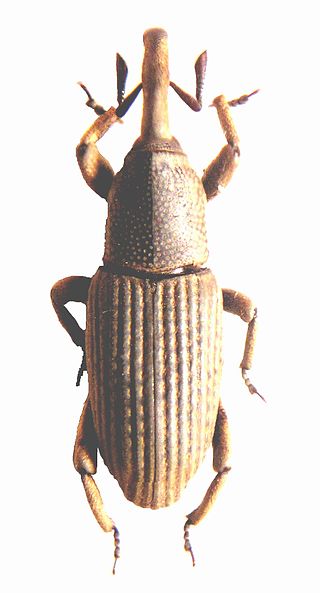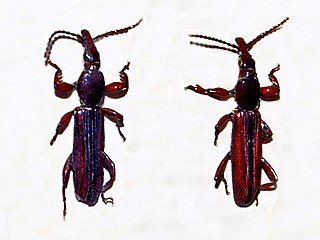
The Curculionidae are a family of weevils, commonly called snout beetles or true weevils. They are one of the largest animal families with 6,800 genera and 83,000 species described worldwide. They are the sister group to the family Brentidae.

Weevils are beetles belonging to the superfamily Curculionoidea, known for their elongated snouts. They are usually small – less than 6 mm in length – and herbivorous. Approximately 97,000 species of weevils are known. They belong to several families, with most of them in the family Curculionidae. It also includes bark beetles, which while morphologically dissimilar to other weevils in lacking the distinctive snout, is a subfamily of Curculionidae. Some other beetles, although not closely related, bear the name "weevil", such as the leaf beetle subfamily Bruchinae, known as "bean weevils", or the biscuit weevil, which belongs to the family Ptinidae.

The New York weevil is a species of primitive weevil; large for weevils (12–18 mm), it is covered with fine bristles and has a regular pattern of light and dark spots. It occurs in the eastern United States and southern Canada.

Stromboscerus is a genus of beetles belonging to the Brentidae, specifically within the subfamily Apioninae. These beetles are known as "straight-snouted weevils" due to their long straight snouts, which differ from the more common curved snouts seen in typical weevils. Stromboscerus species are primarily found in tropical regions of Southeast Asia and Africa, where they inhabit forested areas.
Caridae is a small Gondwanan family of weevils. They are considered part of the primitive weevil group, because they have straight rather than geniculate (elbowed) antennae. The insertion of the antennae on the rostrum cannot be seen from above. Caridae also lack spiracles on abdominal tergites 6 and 7. The prothorax lacks lateral carinae. It has been suggested that the fossil weevil Eccoptarthrus belongs in this family, which would result in a change in the family name ; this proposal has been rejected by most coleopterists (e.g.)

Brentidae, sometimes known as the primitive weevils, is a cosmopolitan family of primarily xylophagous beetles also known as straight-snouted weevils. The concept of this family has been expanded with the inclusion of three groups formerly placed in the Curculionidae; the subfamilies Apioninae, Cyladinae, and Nanophyinae, as well as the Ithycerinae, previously considered a separate family. They are most diverse in the tropics, but occur throughout the temperate regions of the world. They are among the families of weevils that have non-elbowed antennae, and tend to be elongate and flattened, though there are numerous exceptions.

The New Zealand giraffe weevil, Lasiorhynchus barbicornis, is a straight-snouted weevil in the subfamily Brentinae, endemic to New Zealand. L. barbicornis is New Zealand's longest beetle, and shows extreme sexual dimorphism: males measure up to 90mm, and females 50mm, although there is an extreme range of body sizes in both sexes. In males, the elongated snout can be nearly as long as the body. Male giraffe weevils use this long rostrum to battle over females, although small males can avoid conflict and 'sneak' in to mate with females, sometimes under the noses of large males. The larval weevils tunnel into wood for at least two years before emerging, and live for only a few weeks as adults.

Aporhina bispinosa is a species of Brentidae family, Eurhynchinae subfamily, the latter also being treated as Eurhynchidae family.
Desgodinsia is a genus of straight-snouted weevils belonging to the family Brentidae.

Ithystenus curvidens is a species of straight-snouted weevils belonging to the family Brentidae.

Ithystenus is a genus of straight-snouted weevils belonging to the family Brentidae. Species of this genus can be found in Papua New Guinea and Australia.

Schizoeupsalis promissa is a species of weevil in the Brentidae family. It can be found in New Guinea and neighbouring islands. Beetles of this species present great individual variation.

Cephalobarus is a genus of straight-snouted weevils belonging to the family Brentidae. It is monotypic, being represented by the single species Cephalobarus macrocephalus. This species is found in South America.

Eutrachelus temmincki is a species of straight-snouted weevils belonging to the family Brentidae.

Eutrachelus is a genus of straight-snouted weevils belonging to the family Brentidae.

Cerobates tristriatus is a species of beetles belonging to the family Brentidae.

Brentus anchorago is a long-snouted weevil, from the family Brentidae. It is found from southern Florida to South America.
Cerobates elegans is a species of beetles belonging to the family Brentidae, the straight-snouted weevils. It is found in Africa.

Trichapion is a genus of weevil in the family Brentidae.

Trichapion rostrum, the baptisia seed pod weevil or wild indigo weevil, is a species of weevil in the family Brentidae.















